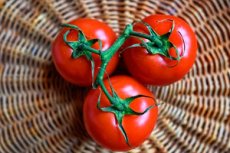Medical expert of the article
New publications
Tomatoes in chronic pancreatitis: fresh, boiled and stewed
Last reviewed: 03.07.2025

All iLive content is medically reviewed or fact checked to ensure as much factual accuracy as possible.
We have strict sourcing guidelines and only link to reputable media sites, academic research institutions and, whenever possible, medically peer reviewed studies. Note that the numbers in parentheses ([1], [2], etc.) are clickable links to these studies.
If you feel that any of our content is inaccurate, out-of-date, or otherwise questionable, please select it and press Ctrl + Enter.

Often, all our culinary preferences are crossed out by certain pathological processes in the body, especially when it comes to the digestive tract. Pancreatitis is an inflammation of the pancreas, a very important link in the chain of food digestion, since it produces pancreatic juice, the food enzymes of which participate in the breakdown of carbohydrates, fats, and proteins in the duodenum. This disease cannot be ignored, it makes itself known with severe pain, nausea, vomiting, weakness during an exacerbation. In chronic cases, the symptoms are somewhat erased, but they force you to "take into account" yourself and not eat everything in a row. Juicy fleshy tomatoes are a favorite vegetable of many people in the summer, and for good reason. They contain glucose, fructose, organic acids, proteins, pectins, carotenoids, B vitamins, including folic acid, ascorbic acid, fatty acids, iron, potassium, phosphorus, magnesium, potassium, zinc. So should you give up such a treasure trove of nutrients or can you still eat tomatoes with pancreatitis?
Tomatoes for chronic pancreatitis
An acute condition definitely does not allow not only vegetables, but also other food, since treatment with hunger is the main component of stabilizing an attack. Refusal to eat eliminates the participation of the pancreas in the digestive act, thereby accelerating the process of inflammation subsiding. After 3-5 days, gentle mashed food is introduced into the diet in small portions, but cooked tomatoes appear only with the final disappearance of the symptoms of the disease. Chronic pancreatitis makes it possible to expand the range of foods consumed, including fresh tomatoes, but necessarily ripe juicy fruits, yellow and pink varieties are preferable due to their greater sweetness. Canned, pickled tomatoes are excluded from the menu due to the fact that preservatives such as vinegar, citric acid, as well as salt and hot spices are used in their preparation. You should also refuse store-bought ketchups, tomato pastes, etc. For the winter period, you can freeze the fruits cut into circles in the freezer and use them to prepare borscht and sauces.
Tomatoes for cholecystitis and pancreatitis
Often cholecystitis - inflammation of the gallbladder and pancreatitis go together. The cause of their occurrence can be a microbial infection or stagnation of bile, leading to the formation of stones in the organ, as a result - increased pressure on its walls, and sometimes their injury. Bile is thrown into the pancreas, which is detrimental to it, since tissues and blood vessels are affected, swelling, hemorrhage, and later inflammation occur. Treatment of pathologies in this case is complex and the main emphasis in it is on diet. Fractional and frequent meals, avoidance of spicy, fried, canned foods are also recommended. Tomatoes for cholecystitis and pancreatitis outside the exacerbation process are allowed under the same conditions as in the previous paragraph.
Benefits
What effect do tomatoes have on the body and what are their benefits? Tomatoes contain serotonin, the hormone of joy, thanks to which they are antidepressants; phytoncides, which have an antibacterial and anti-inflammatory effect, fiber improves intestinal peristalsis, prevents constipation, the seeds perfectly cleanse the blood, prevent the formation of bad cholesterol, and therefore the formation of plaques in the vessels. All this is inherent in fresh fruits. But stewed tomatoes for pancreatitis are even more valuable, since when processed, the content of lycopene increases in them - a powerful anti-cancer component that guards DNA mutations and the growth of malignant cells. Another substance in tomatoes, alpha-tomatine, is able to kill existing tumors, including those of the pancreas.
Contraindications
Despite the many beneficial properties of the fruit, it also has its own contraindications. Food allergies can be an obstacle to their consumption; oxalic acid in its composition can harm people with kidney and joint diseases. The pronounced choleretic effect of tomatoes becomes a taboo for patients with gallstone disease, since the stones can move and clog the bile ducts.
Possible risks
The biggest risks associated with eating tomatoes during pancreatitis are excessive consumption. You can avoid possible complications if you exclude them from your diet during an exacerbation of the disease, and eat one fruit per meal during a stable remission. The main thing is to listen to your body and stop eating them if any unpleasant symptoms occur in the digestive tract. Other troubles are possible if you ignore contraindications.


 [
[